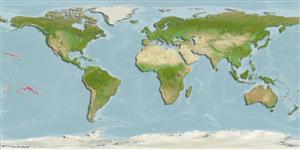Klassifizierung / Names
Namen | Synonyme | Catalog of Fishes(Gattung, Arten) | ITIS | CoL | WoRMS | Cloffa
>
Anguilliformes (Eels and morays) >
Ophichthidae (Snake eels) > Ophichthinae
Etymology: Apterichtus: From the Greek απτερόν (apteron), without fins, and ίχθύς (ichtus, more correctly written ichthys; masculine), fish.; australis: Named australis in recognition of this species' distribution..
More on authors: McCosker & Randall.
Environment: milieu / climate zone / depth range / distribution range
Ökologie
seewasser benthopelagisch; tiefenbereich 12 - 100 m (Ref. 75631). Tropical; 36°N - 34°S, 136°E - 109°W
Western Central Pacific: from Japan and the south Pacific island groups of Rapa, Pitcairn, Easter, New Zealand, and possibly Lord Howe.
Size / Gewicht / Alter
Maturity: Lm ? range ? - ? cm
Max length : 40.0 cm TL Männchen/unbestimmt; (Ref. 75631); 57.0 cm TL (female)
Kurzbeschreibung
Morphologie | Morphometrie
Wirbelzahl: 162 - 167. An elongate, finless species of sphagebranchin ophichthine (sensu McCosker 1977) with: tail 45-57% and head 5-5.5% of total length; 3 preopercular pores and 3 pores in supratemporal canal; teeth conical, uniserial on jaws and vomer; body mostly pale in preservative, creamy dorsally and reddish-brown ventrally with light and dark head markings in life; and mean vertebral formula 82–164, total vertebrae 162–167. Anterior nostril
within an elongate tube, approximately 1/2 the diameter of the eye, its base about midsnout
and anterolaterally directed when viewed from above. Posterior nostril opens in outer lip beneath anterior margin of eye. Branchial openings low, ventral; branchial region modestly expanded, creating a bulbous region in posterior half of head (Ref. 75631).
Occurs over sand with associated rock and coral reef bottoms and collected with ichthyocides and dredges at depths between 12-100 m (Ref. 75631). Largest specimen examined, female at 57 cm TL (Ref. 101270).
Life cycle and mating behavior
Geschlechtsreife | Fortpflanzung | Ablaichen | Eier | Fecundity | Larven
Distinct pairing (Ref. 205).
McCosker, J.E. and Y. Hibino, 2015. A review of the finless snake eels of the genus Apterichtus (Anguilliformes: Ophichthidae), with the description of five new species. Zootaxa 3941(1):49-78. (Ref. 101270)
IUCN Rote Liste Status (Ref. 130435)
Bedrohung für Menschen
Harmless
Nutzung durch Menschen
Mehr Information
Alter/GrößeWachstumLänge-GewichtLänge-LängeLängenhäufigkeitenMorphometrieMorphologieLarvenLarven Pop.Dyn.RekrutierungDichteBRUVS
ReferenzenAquakulturAquakultur ProfilZuchtlinienGenetikElectrophoresesVererbbarkeitKrankheitenVerarbeitungNutrientsMass conversion
PartnerBilderStamps, Coins Misc.LauteCiguateraGeschwindigkeitSchwimmstilKiemenoberflächeOtolithsGehirngrößeSehfähigkeit
Tools
Zusatzinformationen
Download XML
Internet Quellen
Estimates based on models
Phylogenetic diversity index (Ref.
82804): PD
50 = 0.5000 [Uniqueness, from 0.5 = low to 2.0 = high].
Bayesian length-weight: a=0.00089 (0.00039 - 0.00204), b=3.00 (2.80 - 3.20), in cm total length, based on LWR estimates for this (Sub)family-body shape (Ref.
93245).
Trophic level (Ref.
69278): 4.0 ±0.7 se; based on size and trophs of closest relatives
Widerstandsfähigkeit (Ref.
120179): mittel, Verdopplung der Population dauert 1,4 - 4,4 Jahre. (Preliminary K or Fecundity.).
Fishing Vulnerability (Ref.
59153): Moderate vulnerability (43 of 100).
